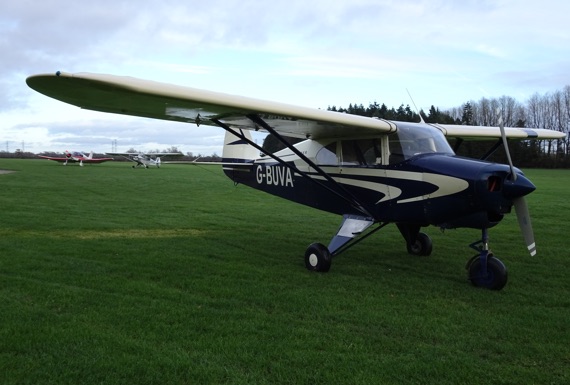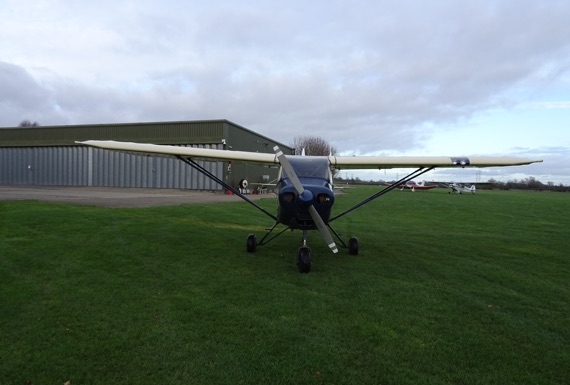PA22 – 160





PIPER PA-20 PACER AND PA-22 TRI-PACER
The PA-20 Pacer and PA-22 Tri-Pacer are a family of four-place, strut based, high wing light aircraft that were built by Piper Aircraft in the post-World War 11 period. The Pacer was essentially a four-place version of the two-place PA-17 Vagabond light aircraft. It features a steel tube fuselage and an aluminium frame wing, covered with fabric, much like Piper’s most famous aircraft, the Cub and Super Cub. An aircraft prized for its ruggedness, spacious cabin, and , for it’s time, impressive speed, many Pacers continue to fly today. Factory installed 125 hp (93kW), 135 hp (100kW) and 150hp (112kW) engine options were available and 160hp (120kW) as well as 180 hp (135kW) engine after-market conversions are an option. An unusual feature of the Tri-Pacer is the incorporation of bungee linked ailerons and rudder. Beside simplifying the co-ordination of in-flight manoeuvres, this system which can easily be overcome by the pilot as required, allowed the installation of a simplified form of autopilot marketed by Piper under the name Auto-control. A small number of PA-22s have been converted to taildragger configuration, resulting in an aircraft that is very similar to a PA-20 Pacer, but which retains the model refinements and features of the PA-22. These conversions are often referred to by owners as PA-22/20s and are often listed in classified aircraft ads as such, although officially such converted aircraft continue to be designated by the FAA as PA-22 Tri-Pacers. When this conversion is accomplished, a 2 puck disc brake conversion is usually installed in place of the original drum brakes and the Lycoming 0-360 180hp engine is the preferred upgrade. Some PA-22s have a Hartzell Constant speed controllable propeller or Koppers Aeromatic propeller. Each of these installations improves performance/economy at the sacrifice of payload.
OPERATIONAL HISTORY
Between 1953 and 1955, the Cuban Army Air Force (Fuerza Aerea Ejercito de Cuba or FAEC) received 7 PA-20s, 4 PA-22-150s and 3 PA-22-160s. During The Cuban Revolution, PA-22s had their rear doors removed and a 30 caliber machine gun installed in its place for use against insurgents, along with hand-dropped grenades. A PA-22 providing ground support for the Cuban Army during the battle of Guisa is believed to be the lone aircraft lost by the Cuban Air Force to enemy fire
G-BUVA SPECIFICATIONS
PIPER PA-22-135 Tri-Pacer (M) (M for modification to 160hp)
Year Built : May 1953
Construction Number : 22-1301
PERFORMANCE
Take off Run (mtr)
340
Best Rate of Climb Speed (kts)
75
Normal Climb (fpm)
85 kts
Vr
45-50 kts
Cruise Speed
90-95 kts
VNE
135 kts
Cruising Speed Sea Level (mph)
125
Max Range
4 hrs to Tanks Dry
Glide Speed
65 kts
V stall full flap
42 kts
V appr
65-60 kts
POWERPLANT
Engine – Lycoming
0-320-B2B
Rated Horsepower
160
Maximum RPM
2700 rpm
Bore (inches)
5.125
Stroke (inches)
4.125
Cruise Power
2400 rpm
Compression Ratio
8.5:1
Fuel Burn
34 ltrs/hr @ 2400 rpm
DIMENSIONS
Wing Span (ft)
29.3
Wing Area (sq ft)
147.5
Wing Loading (lbs/sq.ft)
13.5
Length (ft)
20.6
Height (ft)
8.3
Power Loading (lbss/hp)
12.5
WEIGHT
Gross Weight (lbs)
1950
Empty Weight (lbs)
1222
Useful Load (lbs)
728
FUEL AND OIL
Fuel Capacity (gal)
36
Oil Capacity (qts)
8
BAGGAGE
Maximum Baggage (lbs)
100